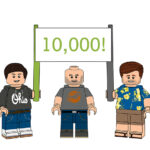
“Everydays — The First 5000 Days” is a collage of all the images that the artist known as Beeple has been posting online each day since 2007. Credit...via Christie's
Do you know what the image above is? It is a collage of 5000 NFTs, do you know what else it is? Art that just sold for $69.3 million dollars!
Going into this weekend I had a rough working knowledge of NFTs but was interested in learning more, and after spending hours of research on the topic I still have a rough working knowledge of NFTs ……… but I’ll share what I have learned on how brands and retailers can leverage them.
Now on to this week’s rabbit hole; NFTs, buckle up this is fascinating.
Let’s start with a simple definition: NFT stands for non-fungible tokens and they show ownership of unique digital items validated by a unique and encrypted code.
- Non – expressing negation or absence
- Fungible – In economics, fungibility is the property of a good or a commodity whose individual units are essentially interchangeable, and each of its parts is indistinguishable from another part. So something fungible can be exchanged for something else of the same kind.
- Token – a (crypto token) is tradable asset or utility that resides on its own blockchain, and allows the holder to use it for investment or economic purposes.
*QuickNote: An NFT is different from a cryptocurrency because, for example, each bitcoin has the same value (like a traditional currency) but each NFT is unique, hence Non-Fungible or Non-Interchangeable.
Years ago I had a friend who was super into Disney and she purchased several ‘cels’ (short for celluloid) which were a piece of one-of-a-kind original artwork used in the production of a movie or show, they were signed and authenticated. NFTs are similar; they are ownership of the original asset but instead of a certificate of authenticity the ownership is validated by blockchain. Can people make copies (of NFTs or ‘cels’)? Absolutely! but there is only one original and as the sharing grows so does the notoriety of the asset and corresponding value of the original.
Though it is also important to note that much like those Disney cels, my friend didn’t own the IP of Mickey Mouse she owned a unique one-of-a-kind piece of artwork, NFTs are similar, they are ownership of the digital content but not the IP surrounding it.
*QuickNote: if you are interested you can buy the original master set-up cel of Pinocchio right now for $28k…. <here>
Now to the more advanced definition: NFT stands for non-fungible tokens like ERC-721 (a smart contract standard) tokens which are hosted on Ethereum’s own blockchain. NFTs are unique digital items such as collectibles or artworks or game items. As an artist, by tokenizing your work you both ensure that it is unique and brand it as your work. The actual ownership is blockchain-managed.
- ERC-731 is the first standard for representing non-fungible digital assets
- Blockchain is a decentralized, distributed ledger that records the provenance of a digital asset
These two methods (blockchain & ERC-731) are really all you need to represent an NFT: a way to check who owns what and a way to move things around.
What I found interesting in my research on NFTs is they aren’t new, they are just newly popular. Their origins can be traced back to blockchain-backed Colored Coins in 2012, but they didn’t really take off until CryptoKitties in 2017. Only now are traditional IP owners, outside of digital artists, getting into the game.
*Quicknote: For a full history lesson on NFTs check out Andrew Steinwold’s The History of Non-Fungible Tokens (NFTs).
Welcome back to those who skipped the rabbit hole. Now on to why should you, as a brand, care about NFTs.

Again, lets start with a simple rationale: NFTs are hot, artistic, and currently on trend and can help drive some buzz around your brand.
Victor Martino at Justfood wrote an excellent article this week on the deeper reason why a brand, or retailer should care.
According to Victor there are 3 general areas of utility for NFTs:
- Promotions (short-term use)
- Marketing (longer-term brand building)
- Driving overall awareness
He also shared 5 reasons or tangible areas to leverage them.
- New product Launches – pretty straight forward – drive awareness for the brand or new product.
- Helping build a beloved brand – NFTs can be a value-added tool in promotions and brand marketing toolbox.
- Part of an integrated campaign – instead of a specific NFT strategy, which may not have the strength to stand alone, have them as a tactic in a larger campaign.
- Teaming up with digital artists – Working with them to create brand specific media. Particularly if your brand has an artistic edge, it could make sense to find an Digital artist who is aligned with your brand purpose. Digital artists are quickly becoming as famous as some traditional artists and are gathering quite the following.
- Audience Engagement – the media landscape is cluttered, NFTs can help break through the noise.
Gary Vaynerchuk wrote an article a couple weeks back and went so far as to say, “Like the internet in the 1990’s or social media in the early 2000’s, NFTs will go down in history as one of the most significant things to happen in modern technology and culture at large. “
While I am not sure I agree with the boldness of that statement it did make me pause and want to learn more. I hope my quick rabbit hole summary does the same for you. If so, your own rabbit hole awaits – here are the articles I recommend starting with.
- Gary Vaynerchuk’s NFT Guide
- Devin Finzer: The Non-Fungible Token Bible: Everything you need to know about NFTs
- Matthew Chaim: A Guide to NFTs, and How They Are About to Revolutionize Pretty Much Everything
- Victor Martino: Why NFTs can offer marketing opportunities for FMCG Brands
- Andrew Steinwold: The History of Non-Fungible Tokens (NFTs)
- CNBC: Beeple NFT becomes most expensive ever sold at auction after fetching over $60 million
As you can see in Google Trends, only time will tell if the hype will continue or die off.

Now on to last weeks top stories:
With last week having Earth Day let’s start with a few sustainability articles.
- Amazon Becomes Europe’s Largest Corporate Buyer of Renewable Energy
- The Climate Pledge Announces More Than 100 Signatories Committed to Achieving Net-Zero Carbon by 2040 or Sooner
- Kroger Celebrates Zero Hunger | Zero Waste Momentum in 2020.
- Kroger is the first retailer in The World to Offer the “Our Brands” Recycling Program as Supported by TerraCycle
and other top stories:
- Kantar buys Numerator – A huge merger of two powerhouses – Our hope is Numerator is left alone to continue to innovate, they have revolutionized the panel insights business.
- Amazon to open first-ever hair salon in London – In the “just because you can, doesn’t mean you should” category Amazon announces they are entering what appears to be a hot bed of activity, hair salons? but it is safe to assume there is an ulterior motive, they are testing technology (AR) and Amazon branded personal care products.
- Target Announces New Installment of The Designer Dress Collection – Fast Fashion competition heats up with Target announcing a new installment of the designer dress collection following the recent announcement Walmart working fashion designer Brandon Maxwell.
- Mattel sales soared 47% as parents bought toys with stimulus checks, toymaker raises outlook
- Digital Payments Lead March Toward a Cashless Society
- Retailers are shifting to an all-digital retail experience, but need to continue to adapt


















No Comments
Leave a comment Cancel